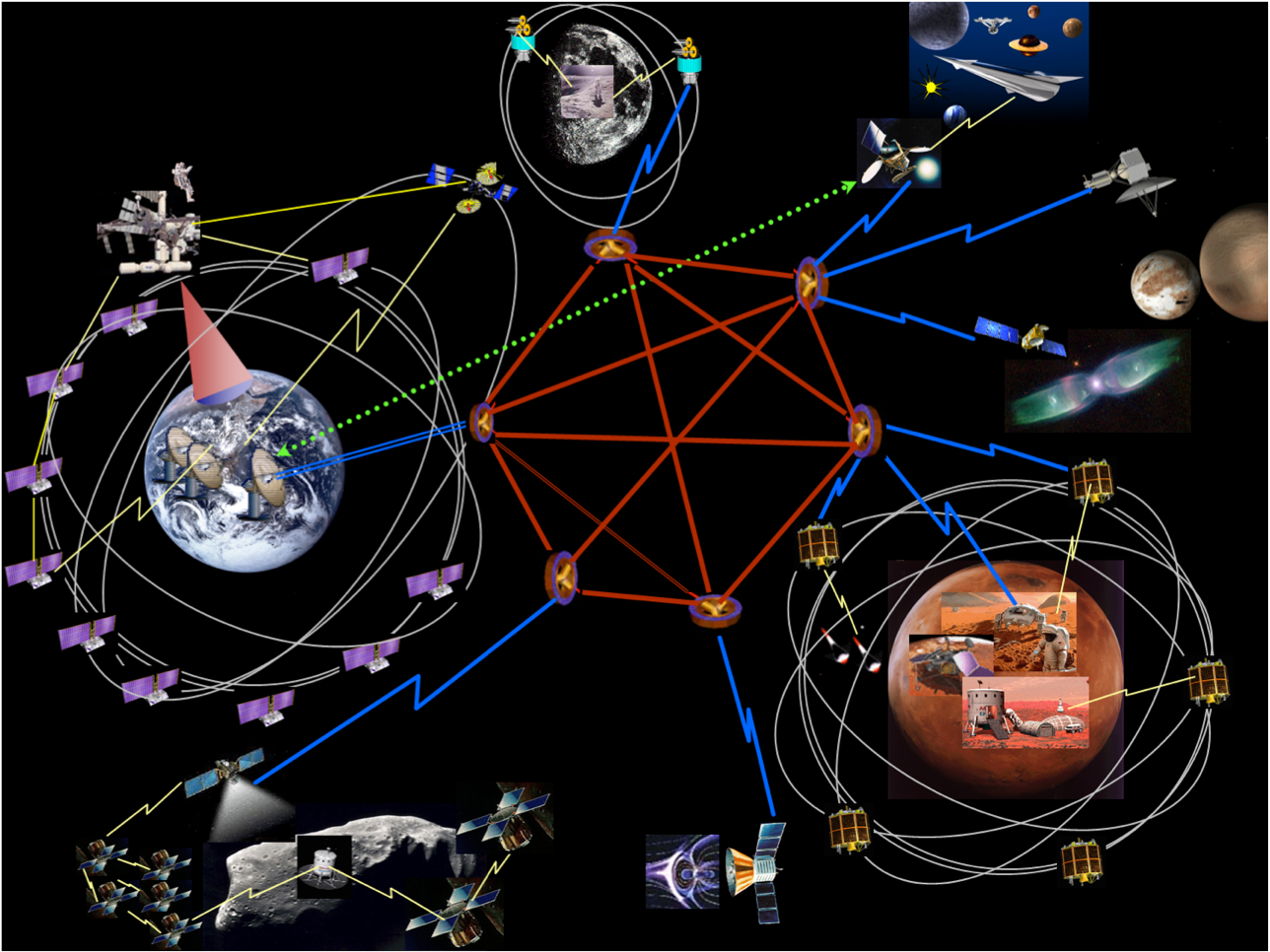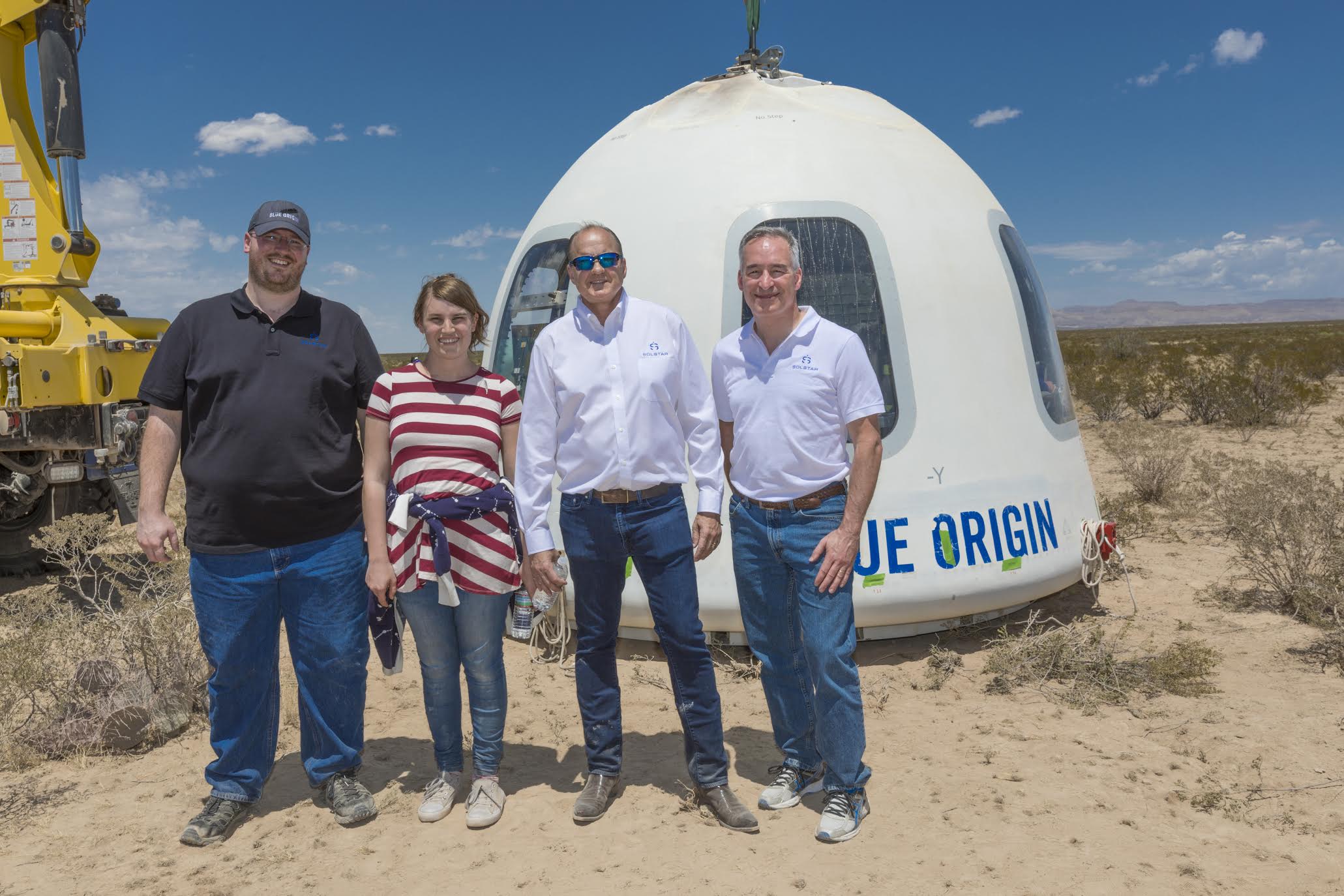How Humans Will Bring the Internet to Space
Credit to Author: Becky Ferreira| Date: Wed, 03 Jul 2019 20:27:35 +0000
At a recent summit about space commerce, Deborah Barnhart, director of the U.S. Space and Rocket Center, was asked if she has any predictions about the first words spoken by humans on Mars. She deferred to the kids and teenagers who attend her center’s Space Camp program for her answer.
“Overwhelmingly, it’s: ‘What’s the Wi-Fi password?'” Barnhart said, according to Jeff Foust of SpaceNews.
While that phrase is not quite so lofty as Neil Armstrong’s historic “One small step for [a] man, one giant leap for mankind,” uttered on the Moon 50 years ago, it does reflect the practical reality that the internet will follow humans wherever we go—even if that means into deep space or to the surface of other planets.
Since the dawn of spaceflight, most spacecraft have communicated by sending radio signals to each other and to ground stations. The flow of information is typically slanted one-way, from the spacecraft to Earth, and the link is not normally shared beyond a few devices.
But if humans want to expand our civilization deeper into the solar system—an aim that is itself a topic of vigorous debate—we will need an orbital internet revolution to support the immense data needs of a spacefaring population. Even if space remains largely the domain of robots, networked devices have the capacity to collect and distribute vast amounts of information relative to the radio links used today.
Anyone who has experienced a spotty connection when their router is in the same room might be skeptical of this vision to build a functional internet in outer space. But since the 1990s, NASA researchers have been developing something called a Delay/Disruption-Tolerant Network (DTN) that could link spacecraft, rovers, and landers all over the solar system to Earth.
“The DTN protocols do for the solar system what internet protocols did for the Earth,” David Israel, a space communications architect at NASA’s Goddard Space Flight Center, said in a phone call. “Internet protocols allowed us to take existing phone lines, in the beginning, and start to network systems together.”
The DTN will offer the same networking advantages to space devices, he explained.

The project to build the internet in space is related to, but distinct from, ongoing efforts to establish huge satellite internet constellations. SpaceX, OneWeb, Boeing, and many other commercial entities are currently racing to launch internet constellations, which will likely lead to the deployment of thousands of new spacecraft in low-Earth orbit over the next decade.
For the most part, satellite internet constellations will be focused on improving the speed, efficiency, and availability of broadband for people and devices on Earth—a.k.a. the terrestrial internet.
DTN, in contrast, would expand the internet of things into deep space and other planets, drastically changing the way humans interact with spacecraft.
The biggest challenge toward that goal is right there in DTN’s name: Delays and disruptions.
Internet traffic on Earth has proliferated due to near-instantaneous connections, but this luxury is not possible in outer space.
It takes minutes for light to travel between Earth and Mars, and hours for it to reach the outer solar system, so DTN must account for big temporal gaps. It must also be resilient to link disruptions caused by planetary bodies and other space phenomena cutting off communication between nodes in the network.
Some 20 years ago, researchers at NASA’s Jet Propulsion Laboratory (JPL) partnered with internet pioneer Vint Cerf to overcome these challenges. J. Leigh Torgerson, a space communications networking architect at JPL, has been on this team since its inception.
“We quickly realized that the standard internet protocols were unsuited to interplanetary use,” Torgerson said in an email. Internet protocols assumed “lots of ‘chatty’ interactions” with only milliseconds of bidirectional delay, he explained, and “no capability to store data along the way.”
To resolve the issue, the DTN team developed the “bundle protocol,” a system that automatically stores data at nodes until the next link in the network chain is firmly established.
Because the DTN is specifically designed for delays and disruptions, it is also useful in environments on Earth that frequently encounter link outages.
“DTN has already been used for distributed earthquake sensor nets, tracking and monitoring wildlife (with DTN-enabled tracking collars), lake water quality monitoring, and many interesting terrestrial applications,” Torgerson noted.
As currently envisioned, DTN would connect internet protocols on Earth—and perhaps eventually other planets—to devices across the entire solar system. In other words, the bundle protocol is not a replacement for conventional internet suites, but rather a space-based overlay that links them.
“If you’re going on vacation to the Moon, and you bring your laptop, you might still use your same Wi-Fi interface and be able to do stuff locally,” Israel speculated. “But if you wanted to be exchanging messages from the Moon to your friend back on Earth, or an adventurous friend on Mars, your message would be carried over the bundle protocol. It wouldn’t be on the local IP.”
The idea of having local hotspots strewn across the solar system has also captured the imagination of people in the private space sector.
In 2013, M. Brian Barnett, a space communications expert and entrepreneur, led a team that sent text messages from Spaceport America to a Virgin Galactic spacecraft more than 72 miles above the ground. Grade school students from Albuquerque, New Mexico, participated in the experiment, so naturally the first text message that arrived on the spacecraft read: “Hasta la vista, baby.”
“That’s the whole beauty of it,” Barnett said in a phone call. “To make it that easy to communicate to something on a spacecraft—either a person, payload, or machine.”
Inspired by the experiment’s success, Barnett founded Solstar Space Co. in 2017 with the aim of building a commercial internet service that could connect customers on Earth to equipment in space.
“One of the first applications is to allow space scientists to have two-way interaction with their experiments during a spaceflight from any internet-connected device,” he said. The long-term goal is to make it easier for “the average person to be able to interact with space exploration, to feel part of it,” Barnett added.
The Solstar team took a major step toward this vision of interactive space Wi-Fi during a 2018 flight test on Blue Origin’s New Shepard capsule, a commercial suborbital spacecraft primarily designed for tourists.

New Shepard carried the Schmitt Space Communicator, a Solstar device named after Apollo 17 astronaut Harrison Schmitt, 66 miles above the Earth’s surface as part of a technology demonstration.
“You can think of it in terms of a router,” Barnett said, describing the Schmitt communicator. “It’s just like the wireless device you have in your house that provides your Wi-Fi, but specially designed for the space environment and for the spacecraft that we’re flying on.”
Despite some signal connection issues during the lead-up to the flight, Barnett and his colleagues were able to use the communicator to post the first commercial tweet in space.
This technology could open up new communication channels for robotic missions, but the Solstar team also wants to develop it for future space tourists. A Wi-Fi hotspot on a spacecraft such as New Shepard would allow customers to get online during a flight and post their obligatory space selfies.
Because communication between spacecraft and ground stations is currently mediated by governmental organizations, which slows down information flow, the Solstar team predicts that there will be a market for more flexible internet links operated by private companies in the future.
This raises the possibility that space internet infrastructure could evolve along similar lines to the terrestrial internet, which is undergirded by non-proprietary protocols but also accommodates commercial service providers.
The interplay between public and private developers ushered in the digital age, but it has also resulted in digital divides and issues of net neutrality. Space internet is not mature enough, at this stage, to be a vector for those sorts of inequities, but it is an issue developers are keeping in mind for the future.
“We want to learn lessons from the internet,” Israel said. “We’re going into an era where it’s very much like the early internet days. There’s not yet a big commercial market and we’re putting the basic pieces into place so we want to strive to set up that same kind of open architecture.”
In addition to building a non-proprietary base infrastructure, regulatory bodies such as the Consultative Committee for Space Data Systems (CCSDS) must anticipate the cybersecurity risks of an interplanetary internet.
Israel pointed out that encryption will be a particularly important feature for DTN, to prevent hackers from copying or altering bundles of information that will be stored at individual nodes. “We’re building things better to address security concerns and issues right from the beginning,” he said.
Torgerson said that DTN “was designed from the outset to thoroughly address cybersecurity” and that the network’s security protocols are standardized by CCSDS and are also being standardized by the Internet Engineering Task Force.
The idea of scaling up the internet of things to the final frontier used to be a hypothetical, but it is now steadily working its way to reality. DTN has been tested out many times in orbit, and a version is currently in use on the International Space Station. NASA’s Plankton, Aerosol, Cloud, ocean Ecosystem (PACE) spacecraft, which is scheduled for launch in 2022, is slated to be the first science mission to use DTN.
Meanwhile, space agencies in Europe, Korea, and Japan are also integrating DTN concepts into their future mission plans.
As Israel noted, one of the most tantalizing things about these developments is that they seem to mirror the early days of the internet on Earth. While the basic utility of the internet was accepted from its genesis, nobody could have foreseen all of its kaleidoscopic permutations or the profound ways it would reshape society.
Likewise, it is difficult to anticipate the finer details of a future in which orbiters, rovers, deep space probes, and even human space habitats are nodes on the internet of things. The only safe prediction is that those intricacies will be sculpted by complex interactions between governments, businesses, and individual users—just like the terrestrial internet.
The first words spoken on Mars may well be some variation of: What’s the Wi-Fi password? But a good follow-up question would be: What do you want to do once you’re online off-Earth?
This article originally appeared on VICE US.